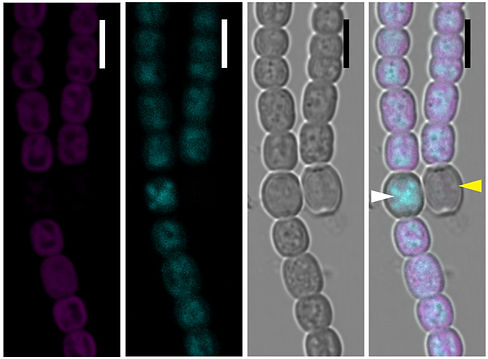Our Research Projects
In our group we investigate photosynthesis at different scales, from protein to membrane to ecosystem level. We believe that in combination with nitrogen fixation, it can provide sustainable solutions to the energy crisis.
Photosynthetic life in extreme environments: Diversity, distribution and ecophysiology
We study cyanobacteria photosynthesizing in near-infrared (far-red) light. Their contribution to primary production is still unknown, although we have shown that they are widely distributed (Antonaru et al., 2020, ISME J).
They are commonly found in shaded environments, including extreme places such as salt flats, and hot/cold deserts.
Our work ranges from the initial sampling to isolation and the description of new genera. By using fluorescence microscopy and spectroscopy, we can untangle the role of these cyanobacteria in their environments.


Light-driven nitrogen fixation and symbioses
Atmospheric nitrogen fixation is an energy-intensive process. Cyanobacteria can uniquely do it with oxygenic photosynthesis by forming special cell types called heterocysts. Inspired by them, we aim to design a nitroplast, a photosynthetic N2-fixing organelle and introduce it into crop plants.
By shifting the photosynthetic properties of the nitroplast into the near-infrared, competition between plant and cyanobiont for the same wavelengths could be avoided and thus make the fixation more successful. We have recently discovered such a system in a cyanobacterium under natural conditions that can also infect liverworts. The photosynthetic properties and its potential to fix nitrogen with far-red light are currently investigated by using various spectroscopy, microscopy and biochemical methods incl. nitrogenase activity assays.
Oxygenic photosynthesis at its energy limit: Membrane and protein remodeling for growth in the near infrared
Most oxygenic photosynthesis uses chlorophyll a to convert solar energy into the chemical energy that powers the biosphere. Chlorophyll a absorbs sun light only up to 700 nm, the so-called "red limit", which coincides with the classical energy threshold of the primary photosynthetic reactions.
Some cyanobacteria are able to extend this limit into the near-infrared by using modified chlorophylls, such as chlorophyll f. In this project, we aim to understand how photosynthetic membranes and protein complexes change. We have shown that they allow oxygenic photosynthesis to function efficiently when using far-red light that has less energy per photon than visible light does (Nürnberg et al., 2018, Science).


Genetic modification of cyanobacteria
In order to understand the function of proteins and localise them within the cells, we remove genes or add tags in cyanobacterial model organisms such as Synechocystis sp. PCC 6803 and Anabaena sp. PCC 7120.
(see e.g. Opel et al., 2022, ACS Synth Biol)
We are also developing new mutagenesis strategies for non-model organisms, including one of the most complex prokaryotes, Mastigocladus laminosus.
(genus overview in Alcorta et al., 2019, Extremophiles)
Multicellularity and cellular communication in filamentous cyanobacteria
Cyanobacteria include complex multicellular forms with specialized cells. This requires extensive cell-to-cell communication and regulation. We have developed methods to trace and quantify exchanges between cells, using fluorescent probes and FRAP.
(see e.g. Nürnberg et al., 2015, mBio)
New approaches will investigate communication in symbioses such as lichens and bryophytes.



Improved photosystem coupling and a novel spectral-tuning approach in light-driven formate production
Various strategies have been proposed to reduce CO2. Here we focus on a purely enzymatic approach using the well-studied biocatalysts formate dehydrogenase (FDH), the mediator cytochrome c6 and the power engine photosystem I. An efficient coupling of these proteins would allow the light-driven reduction of CO2 and the formation of formate which can be used as liquid energy carrier in fuel cells, as a hydrogen storage material, or feedstock for the synthesis of fine chemicals.
Other Projects
Living Technology
The Nürnberg Lab hosts the Living Technology Project, a student research initiative striving to build a carbon capture technology based on photosynthesis.
Inspired by the Azolla Event 49 million years ago, we hope to bypass current difficulties of fixing CO2 chemically through photosynthetic activity.

Methods
We use a wide range of methods to study photosynthesis and cyanobacteria, including bioinformatics, molecular biology, biochemistry and biophysics.











